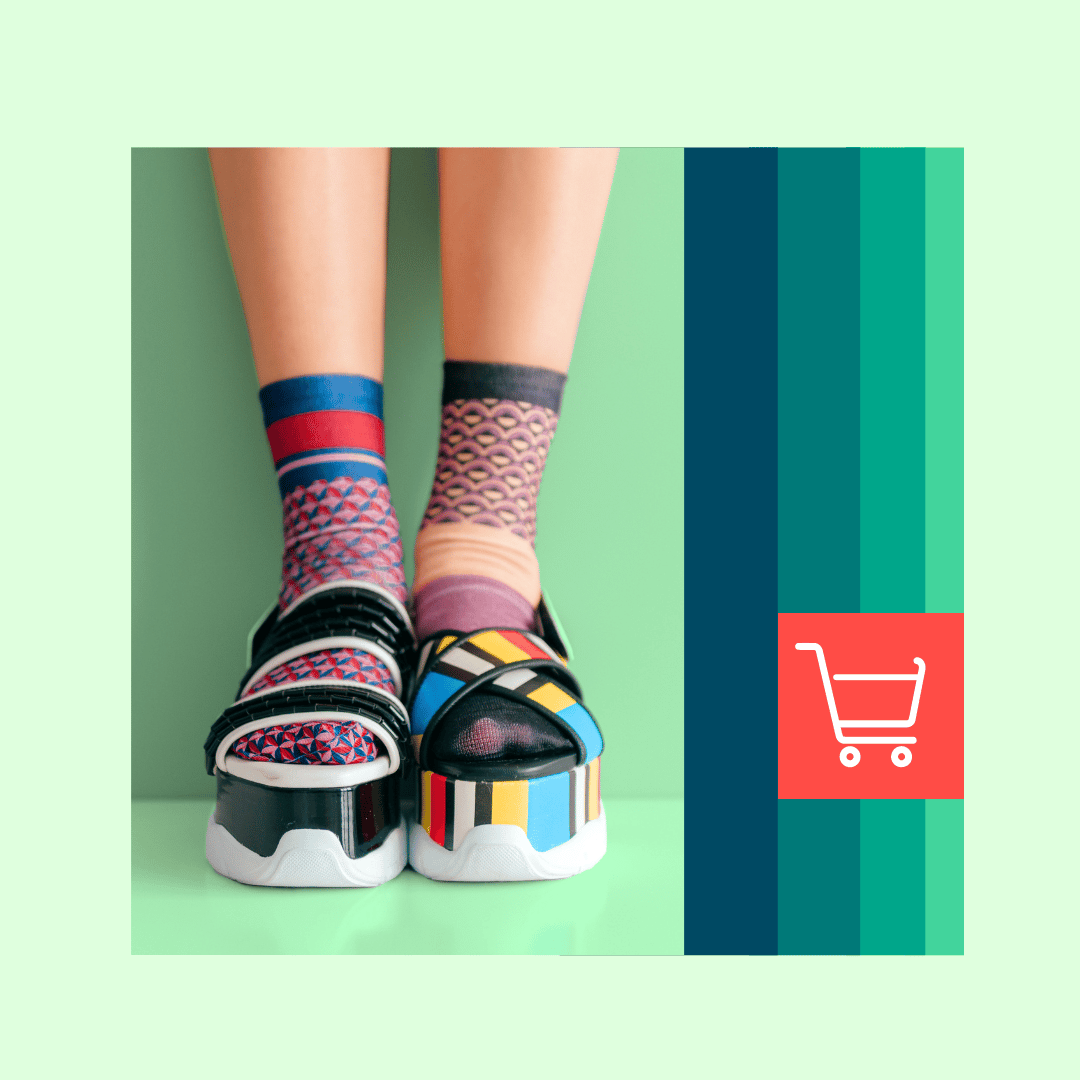A social media ecommerce strategy can help you build brand awareness, communicate with customers, and generate more sales for your online store.
Social media and ecommerce are two peas in a pod. Ecommerce marketers are using social platforms to build brand awareness, connect with customers, and promote products through organic posts and targeted ads.
And these strategies work. Consider these stats from Hootsuite’s Global State of Digital 2022 report:
- 57.5% of internet users aged 16 to 64 buy a product or service online weekly
- 26.5% of social media users go to social platforms to find products to buy
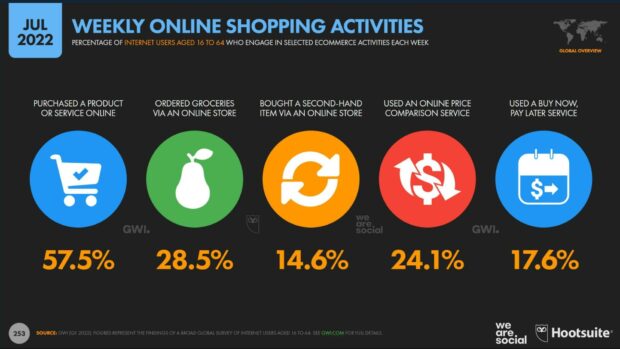
In this article, we’ll walk through how to use social media ecommerce to grow your business.
What is social media ecommerce marketing?
Social media ecommerce marketing is the practice of using social media to promote an online store by generating brand awareness, interest in products or services, and sales.
Popular social media ecommerce tactics include:
- Promoting and driving traffic to an ecommerce website or branded app
- Selling products directly on social media
- Engaging with customers and prospects directly on social channels
- Providing pre- and post-sale support to customers
- Collecting insights about your industry and market
- Building an online social media community around your brand
Many brands use all of the above tactics to create a thriving social media ecommerce marketing strategy.
Social media ecommerce marketing vs. social selling vs. social commerce
You’ve likely heard the terms social media ecommerce marketing, social selling, and social commerce. They’re often used interchangeably, but they’re not the same thing.
Let’s take a look at how they’re different.
Social media ecommerce marketing
This is when ecommerce businesses use social media as a marketing channel to promote their brand, product, or service to drive more sales and connect with customers.
Social selling
This is when brands use social media to identify, connect with, and nurture sales prospects. It’s a tactic that helps businesses reach and engage with sales targets via social media.
Think of social selling as modern relationship-building. The goal is to connect with potential customers, and offer support and guidance. Then, when that person is in buy mode, your product or service comes to mind first.
Social commerce
This is when brands sell products or services directly on social media using native solutions like Facebook Shops, Instagram Shops, Pinterest Product Pins, or TikTok Shop.
Social commerce lets customers shop, select, and complete purchases without leaving social media apps.
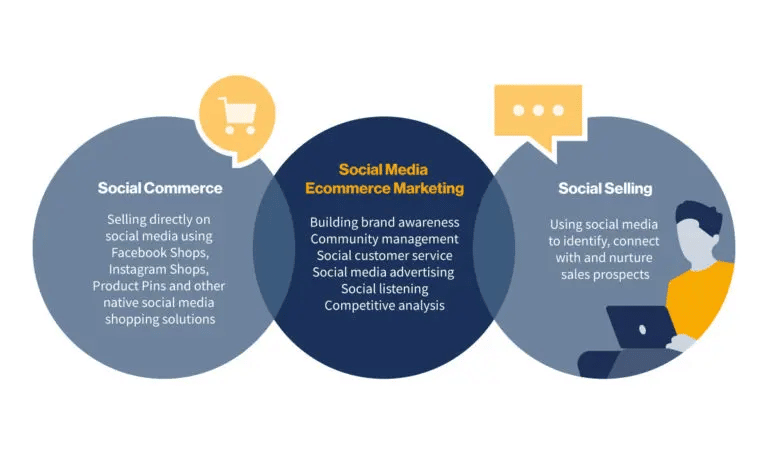
6 ways brands can use social media for ecommerce
1. Build brand awareness
There’s no better marketing channel for generating buzz than social media. It’s the perfect place to promote your new store, products, services, events, or promotions. And it’s great for engaging in conversations with your target audience.
To successfully build brand awareness, create a consistent posting strategy with a unified voice and message. Publish on multiple channels, in multiple formats. Engage with hot topics, hashtags, and in direct conversations with users.
Building brand awareness is a process. It takes time. To help, follow these tips:
- Showcase your personality and values
- Be consistent in your messaging
- Speak to the right people
- Demonstrate your value
- Respond to feedback
Brand building example: tentree
Tentree is a clothing company that doesn’t shy away from their mission to promote sustainability. They lean into this message on social media. Take this tweet, for example, that showcases self-sustaining cabins in Finland. The post doesn’t directly promote Tentree’s products, but it’s inspiring and aesthetically pleasing, and it reinforces what the brand is all about.

2. Advertise
There’s no more powerful advertising channel out there than social media. The global ad reach on social media is massive, and growing rapidly.
Here’s the ad reach by social media channel, according to Hootsuite’s reporting:
- 2.17 billion on Facebook Ads
- 1.44 billion on Instagram Ads
- 1.02 billion on TikTok Ads
- 849.6 million on LinkedIn Ads
The audiences are huge. Too huge, in fact. Which is why these social channels also have
powerful targeting and segmentation tools.
To advertise effectively on social media, make sure you:
- Identify your target market and audience
- Layer targeting parameters to zero in on that audience
- Create a compelling content strategy to speak to them
- Define your goals and KPIs for each channel
- Pick the ad types that align with your goals
- Specify the right conversion metrics
The goals you have for social media advertising will dictate the ad types, KPIs, and conversion metrics you choose. And the platforms you invest in.
A goal to drive brand awareness, for example, is best suited to:
- Image, video and carousel ads, that drive
- Store visits, ad impressions, and engagement
If you want to drive sales, you’d want to go with:
- Product, collection, or shopping ads, that drive
- Direct purchases, product page visits
To get started, select your goal. Then define the type of ads and targeting you need. And then define how you’ll track success.
You can learn more about ad objectives and formats across different platforms in our guide to social media advertising.
Advertising example: The Bay
The Bay is a major Canadian department store that uses Instagram advertising for brand building and product sales. In the ad below, they combine their unique visual flare with shoppable catalog ads.

3. Sell products directly on social media
Social commerce has never been easier. Currently, there are four social media apps with native built-in social selling capabilities:
- TikTok
Twitter and Snapchat have also both partnered with Shopify to create social commerce tools of their own.
This is where social media ecommerce marketing overlaps with social commerce. Where the reach and brand-building power of social media can lead to direct business.
The benefits of using social commerce solutions include:
- They’re free to set up
- They create memorable, interactive online shopping experiences
- They streamline the sales process
- They extend the places in which sales can happen
- They enable headless commerce
- They give you the ability to create live shopping experiences
If you’d like to give social commerce a try, check out these guides to setting up:
Shoppable ads example: CCM
CCM’s Instagram is a direct blend of lifestyle marketing and shoppable product placements. They showcase the professional hockey lifestyle, and make the gear that NHLers use available in just a few clicks.
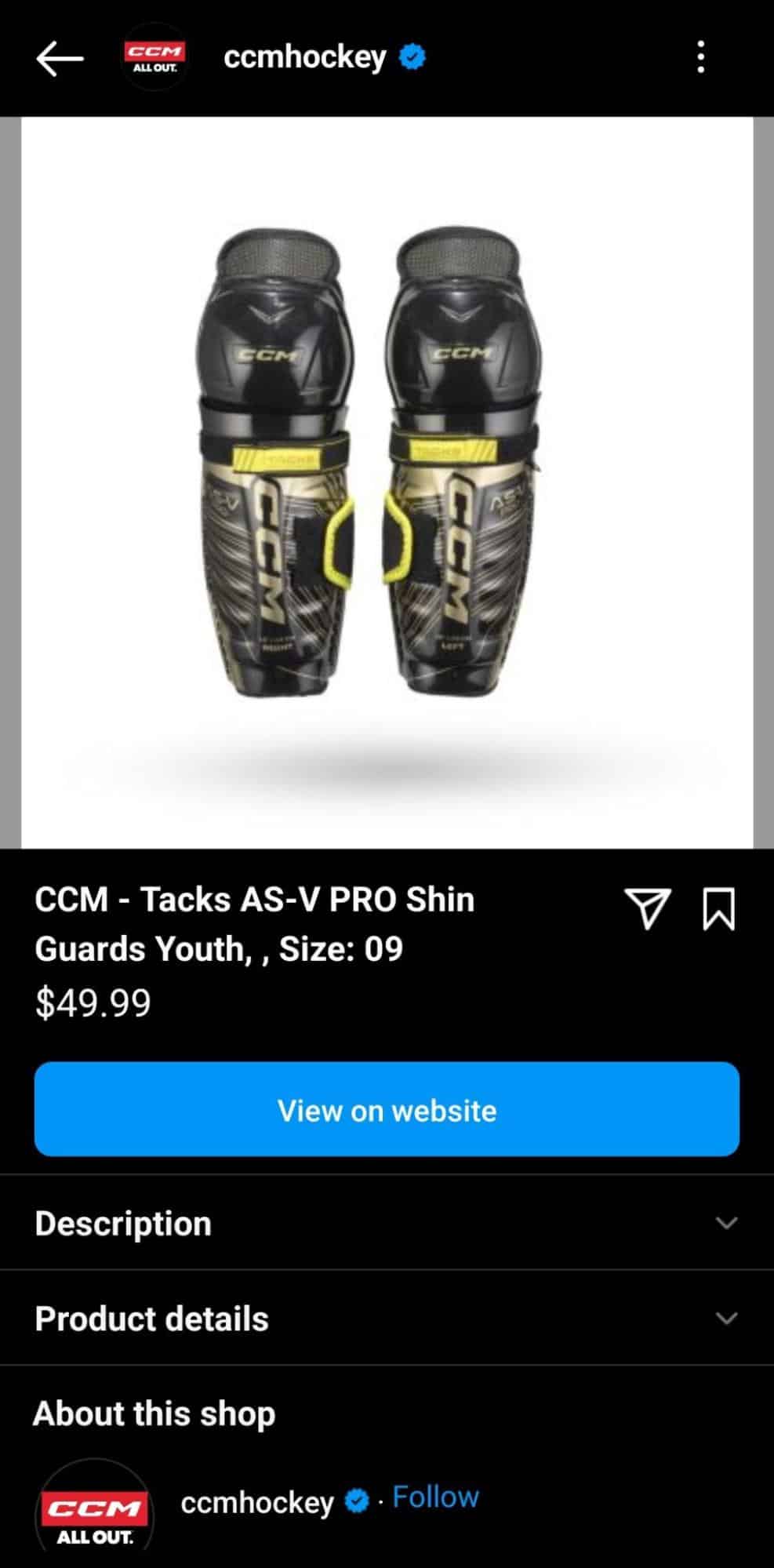
4. Increase sales with an ecommerce chatbot
To paraphrase Uncle Ben, with great scale (and sales) comes great responsibility. Brands who expand their footprint and sales capacity on social media need to make sure they scale customer support as well.
Ecommerce chatbots are the most effective way to do that. By leveraging an AI-powered chatbot like Heyday by Hootsuite, brands can:
- Easily connect and interact with consumers 1:1 across multiple channels
- Offer pre- and post-sale support at any time
- Offer discounts, suggest products, and highlight promotions automatically
- Answer FAQs
- Guide users through the buying process
And they can do all that at scale for a fraction of the cost of a support team.
Interested? Learn how to use chatbots for Instagram and Facebook.

Ecommerce chatbot example: DeSerres
Arts and crafts supply store DeSerres saw significant sales growth during the pandemic. To keep up with demand, they installed an AI chatbot on their website. One of its main jobs is to make product suggestions to help answer user queries and drive sales.
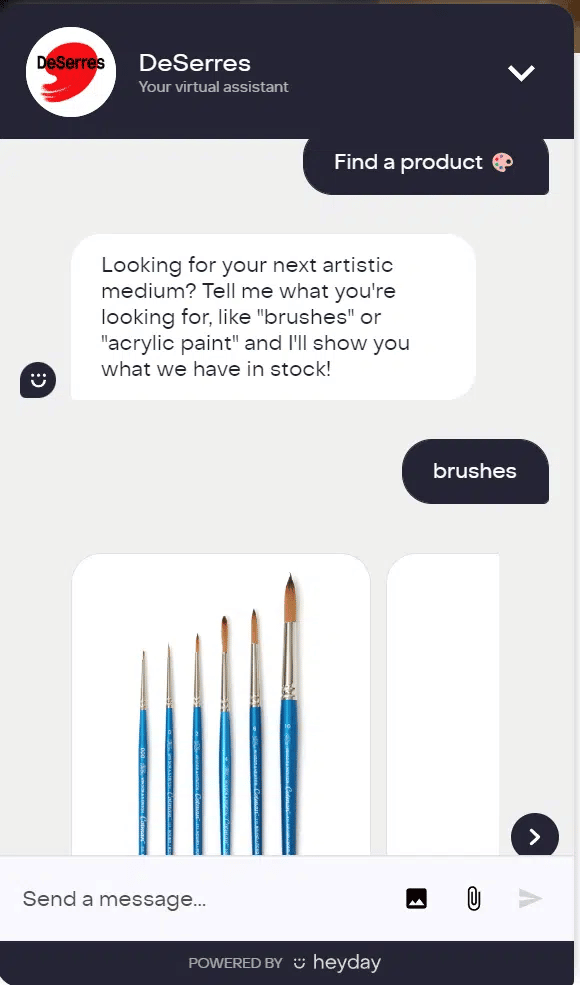
5. Customer support
No social media ecommerce strategy is complete without taking customer support into account. Social platforms are ideal for nurturing and supporting existing customers. Because of that, they’ve become a de facto customer support channel for most major brands.
Customers may come to your profile to:
- Find information
- Ask questions
- Give feedback
- Engage with your content
- Offer insights into what they want
Brands—and social media managers—must be prepared to handle those incoming comments and DMs. If you can’t, then an ecommerce chatbot may be able to help.
Apart from providing a good customer experience, social proof is another reason to make sure your social profiles are interactive. Prospects will see public interactions with customers. This will impact whether or not they want to make a purchase. How you handle complaints publicly speaks volumes about how you handle them privately.
Customer support example: Ray-Ban
Being on social media opens brands to feedback—positive and negative. Here, Ray-Ban responds to a particularly hostile comment directly, and immediately tries to find a remedy.
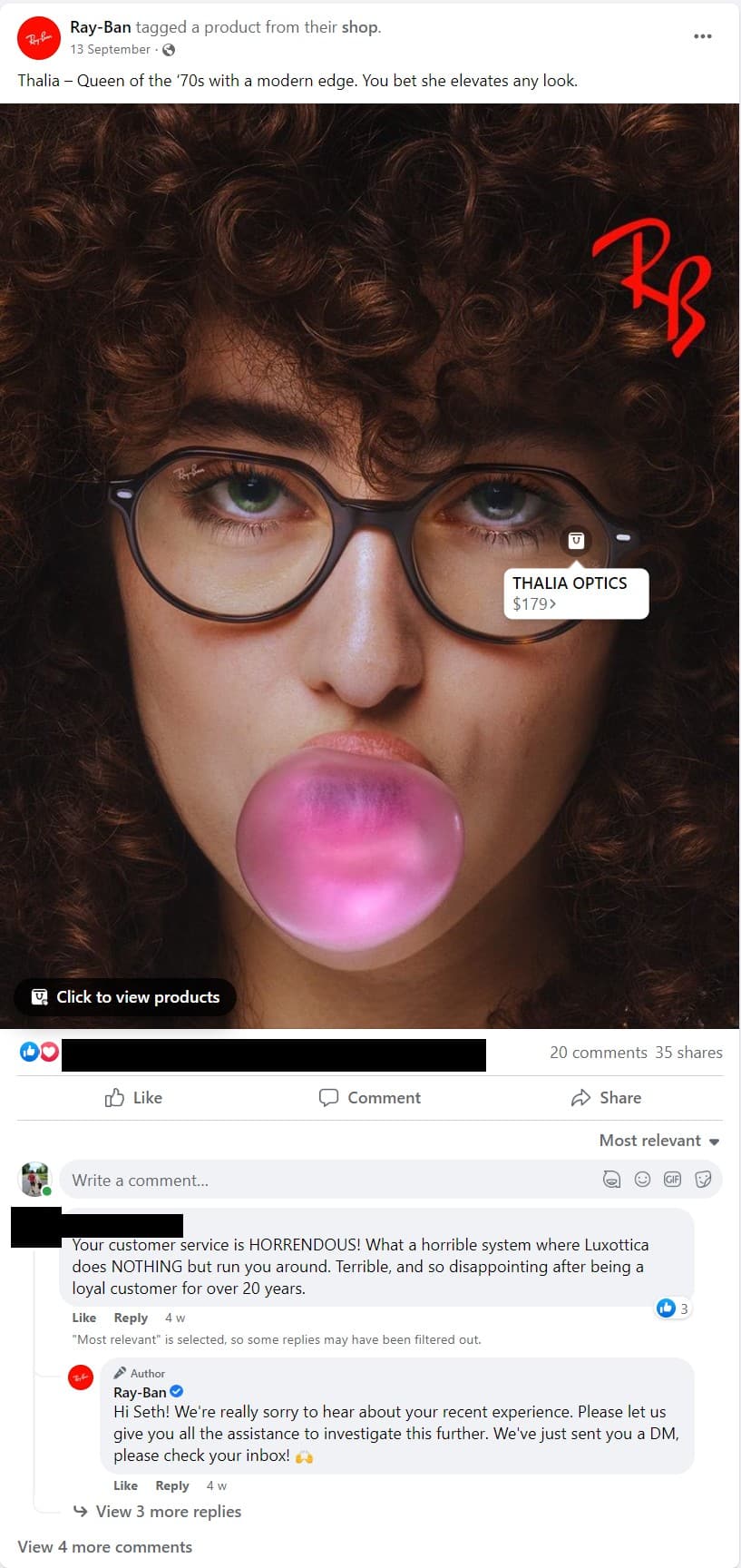
6. Social listening
With the right tools, social media can be a data goldmine for your brand. Social listening is the process of scanning social media for mentions of your brand or relevant conversations.
67% of marketers say social listening is a useful way to track and understand their customer needs. Not only that, it offers invaluable insights like:
- What products people love most
- Where recurring problems or issues might lie
- The public’s sentiment toward your brand
This allows you to address issues, seize opportunities, and refine your message to meet market demands.
https://youtube.com/watch?v=qCAKH9SaWnc%3Fenablejsapi%3D1%26038%3Borigin%3Dhttps%253A%252F%252Fblog.hootsuite.com
7 actionable social media ecommerce tips
At this point, you’ve probably got a solid idea of where you’ll focus your social media efforts. But tips like “build brand awareness” are sometimes easier said than done.
Need some actionable next steps? Here are some bonus tips to help steer you in the right direction.
1. Showcase your personality
Buyers want to make a connection with brands. How do you do that? By being yourself. And not being afraid to show some personality.
Social media is the perfect tool to craft your brand personality. You can use humor, engage in a social cause, be the most responsive brand in the market, and more. Whatever you do, the goal is to make it easy for potential buys to remember and recognize you.
Let’s look at the king of brand personality on Twitter: Wendy’s.
https://platform.twitter.com/embed/Tweet.html?dnt=true&embedId=twitter-widget-0&features=eyJ0ZndfdGltZWxpbmVfbGlzdCI6eyJidWNrZXQiOlsibGlua3RyLmVlIiwidHIuZWUiLCJ0ZXJyYS5jb20uYnIiLCJ3d3cubGlua3RyLmVlIiwid3d3LnRyLmVlIiwid3d3LnRlcnJhLmNvbS5iciJdLCJ2ZXJzaW9uIjpudWxsfSwidGZ3X2hvcml6b25fdGltZWxpbmVfMTIwMzQiOnsiYnVja2V0IjoidHJlYXRtZW50IiwidmVyc2lvbiI6bnVsbH0sInRmd190d2VldF9lZGl0X2JhY2tlbmQiOnsiYnVja2V0Ijoib24iLCJ2ZXJzaW9uIjpudWxsfSwidGZ3X3JlZnNyY19zZXNzaW9uIjp7ImJ1Y2tldCI6Im9uIiwidmVyc2lvbiI6bnVsbH0sInRmd19jaGluX3BpbGxzXzE0NzQxIjp7ImJ1Y2tldCI6ImNvbG9yX2ljb25zIiwidmVyc2lvbiI6bnVsbH0sInRmd190d2VldF9yZXN1bHRfbWlncmF0aW9uXzEzOTc5Ijp7ImJ1Y2tldCI6InR3ZWV0X3Jlc3VsdCIsInZlcnNpb24iOm51bGx9LCJ0Zndfc2Vuc2l0aXZlX21lZGlhX2ludGVyc3RpdGlhbF8xMzk2MyI6eyJidWNrZXQiOiJpbnRlcnN0aXRpYWwiLCJ2ZXJzaW9uIjpudWxsfSwidGZ3X2V4cGVyaW1lbnRzX2Nvb2tpZV9leHBpcmF0aW9uIjp7ImJ1Y2tldCI6MTIwOTYwMCwidmVyc2lvbiI6bnVsbH0sInRmd19kdXBsaWNhdGVfc2NyaWJlc190b19zZXR0aW5ncyI6eyJidWNrZXQiOiJvbiIsInZlcnNpb24iOm51bGx9LCJ0ZndfdmlkZW9faGxzX2R5bmFtaWNfbWFuaWZlc3RzXzE1MDgyIjp7ImJ1Y2tldCI6InRydWVfYml0cmF0ZSIsInZlcnNpb24iOm51bGx9LCJ0Zndfc2hvd19ibHVlX3ZlcmlmaWVkX2JhZGdlIjp7ImJ1Y2tldCI6Im9uIiwidmVyc2lvbiI6bnVsbH0sInRmd190d2VldF9lZGl0X2Zyb250ZW5kIjp7ImJ1Y2tldCI6Im9uIiwidmVyc2lvbiI6bnVsbH19&frame=false&hideCard=false&hideThread=false&id=1578434005996695553&lang=en&origin=https%3A%2F%2Fblog.hootsuite.com%2Fsocial-media-ecommerce%2F&sessionId=1dbb973982c9e3e0a1971dc009c6edd35499a5b7&theme=light&widgetsVersion=a3525f077c700%3A1667415560940&width=550px
Wendy’s pulls no punches when it comes to their social profiles. They make jokes, they roast people, and they engage in banter with competitors. As a result, they’ve grown a cult following of online fans.
2. Collaborate with others
Collaboration is the key to success on social media. Engaging influencers and partnering with other brands are two ways to turn collaboration profitable.
Influencer marketing is worth $16.4 billion in 2022. And it’s not hard to see why. It’s become one of the most popular social ecommerce marketing tactics to expand reach, social proof products, and win new followers.
Collaborations are equally important. More and more brands are partnering with other companies who have similar audiences. When they do, may create high-value bundle giveaways or promotions that each brand co-markets to their respective followers.
In both cases, brands amplify and validate their products and services to enormous social media audiences.
Glamnetic is one example. This Shopify customer uses an extensive network of influences to promote their products. They provide influencers with free products, and ask them to demonstrate them on their channels. In return, the influencers get an affiliate link that gives them a kickback on sales generated.
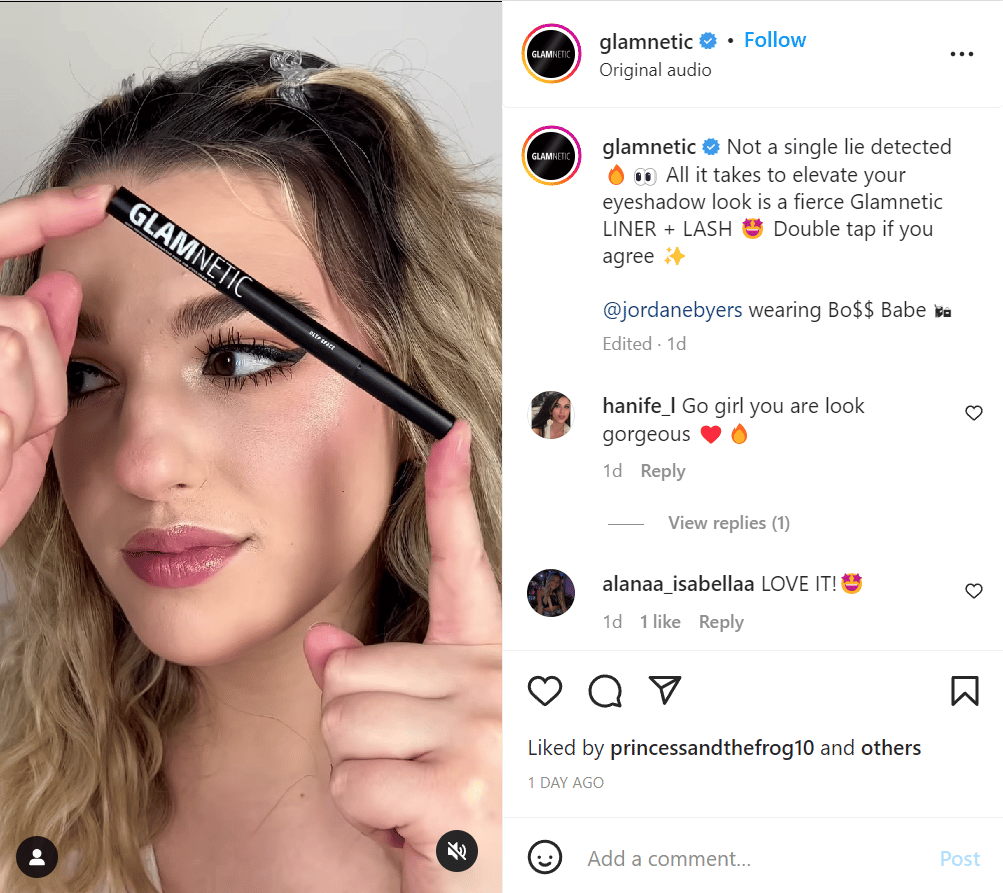
3. Use video as much as possible
Video has quickly become the most popular—and influential—content type of social media. 88% of people say they want to see more video content from brands. And the same amount said they’ve been convinced to buy a product or service after watching a brand’s video.
It’s no coincidence that TikTok and Instagram Stories are two of the most popular channels in the social media game. Both offer invaluable opportunities for brands to post paid and organic video content to engage users.
Video doesn’t have to be expensive. It doesn’t need high production value or glossy effects. All it has to do is demonstrate value, showcase your personality, and speak to your customer.
Take Vessi, for example. They use Instagram Stories to promote products, share brand and career stories, and generally create a more engaging experience.

4. Post user-generated content
User-generated content packs an enormous punch on social media. This includes content like user reviews, product unboxings, or anything in which a customer uses or discusses an item they purchase.
This type of content ties back to the importance of positive reviews, social proof, and influencers. It’s real-world people providing commentary about your product. That’s a goldmine for brands to leverage on social media.
Encourage your customers to share pictures and videos featuring your products on social media. Ask them to tag your brand. When they do, reshare the content to your own profile.
Bam. Now you have free content that’s social proofed and shows your product in action.
This tactic also has the added benefit of making customers feel connected with your brand. It creates engagement, and shows that you hear and value your customers. Wins all around.
Here’s another example from Vessi where they share an unboxing video from a customer.

5. Work smart (and use social media management tools)
51% of social marketers find managing all messages and posting schedules in one place to be their biggest challenge. Any ecommerce social media manager reading this is nodding their head furiously right now.
To make scaling and managing their social media presence easier, most leading brands turn to tools like Hootsuite.
Social media management tools let you:
- Manage multiple social media accounts at the same time
- Ensure content and messaging is unified across all channels
- Track and organize conversation with your audience
- Schedule posts ahead of time
- Monitor social mentions and relevant conversations
- Track and analyze performance
Social media management tools are non-negotiable for ecommerce brands that want to scale multiple content streams across multiple channels. If you haven’t onboarded one yet, you’ll thank us when you do.
6. Post often
Post early, and post often. That should be a mantra for any ecommerce brand starting out on social media.
Posting often helps you gain traction, test what works, and build a following. Having a regular posting schedule, likewise, ensures that you are consistent with your social media strategy.
This is how you keep your brand top of mind and build an online community.
The best social media ecommerce tools for 2023
It’s tough to work smart when you don’t have the right tools. Here are two essential social media ecommerce tools you can start using today.
Heyday: conversation AI chatbot
Heyday is an AI-driven chatbot that connects your ecommerce website with social channels like Facebook Messenger, Instagram and Whatsapp.
Leading ecommerce brands use Heyday to:
- Answer FAQs
- Assist with package tracking
- Provide product recommendations to customers and prospects
- Offer post-sale support
- Gather feedback on user needs
- Provide multilingual support
Even better, Heyday seamlessly integrates with Shopify stores. Simply download the app and install it on your store — and you can start offering automated FAQs on Shopify in less than 10 minutes.
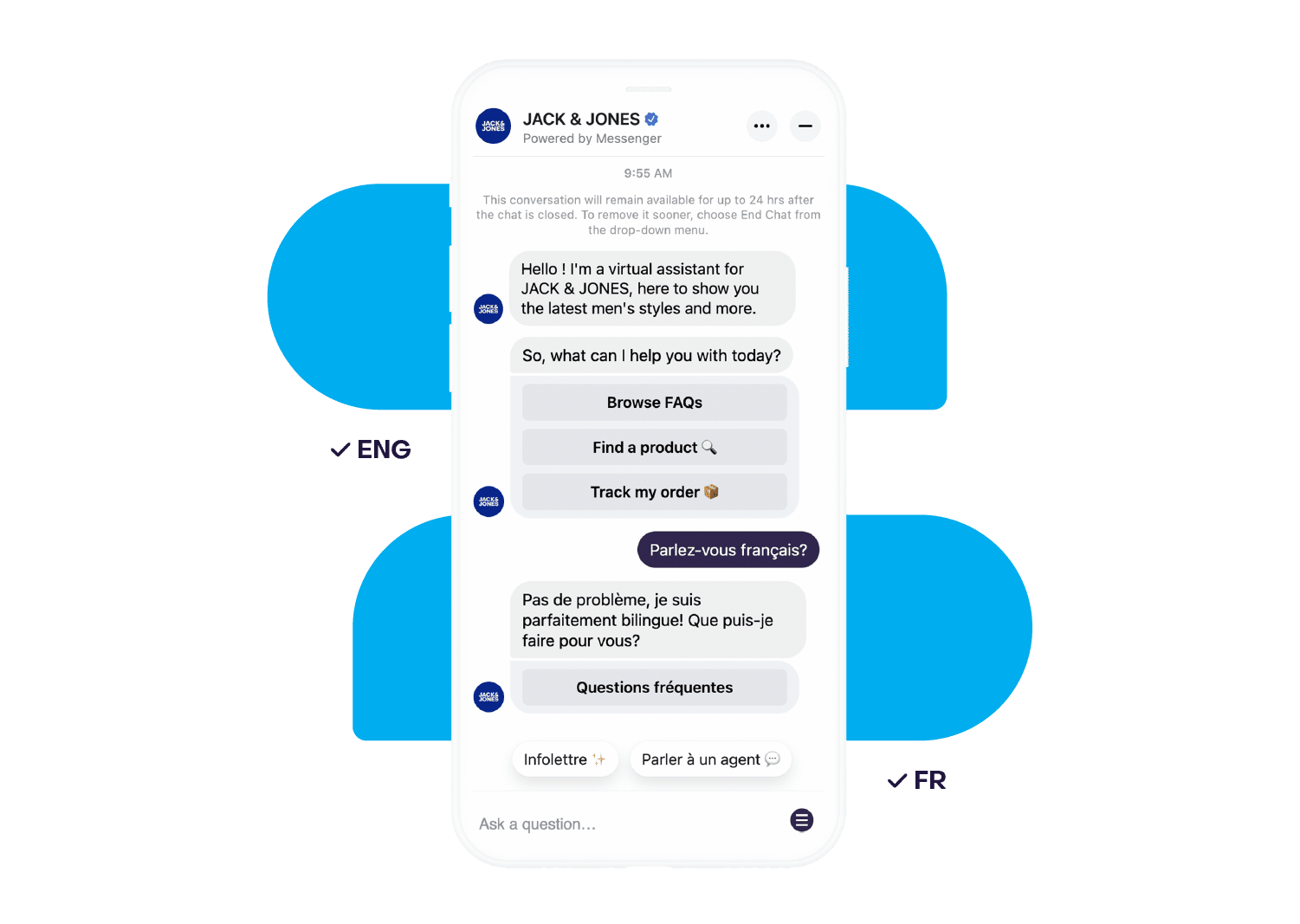
Hootsuite: social media management dashboard
Hootsuite helps ecommerce businesses of all sizes (including solopreneurs!) schedule and publish posts, engage with your followers, and track your success across platforms from a single, easy to use, interactive dashboard.
Here are some Hootsuite features that ecommerce brands find particularly useful:
- Create Instagram posts with shoppable product tags in Composer (and schedule them to go live at recommended times when your audience is the most active online)
- Answer comments and DMs from all your social accounts in one place
- Set up a social listening stream to track what people are saying about your brand and your competitors
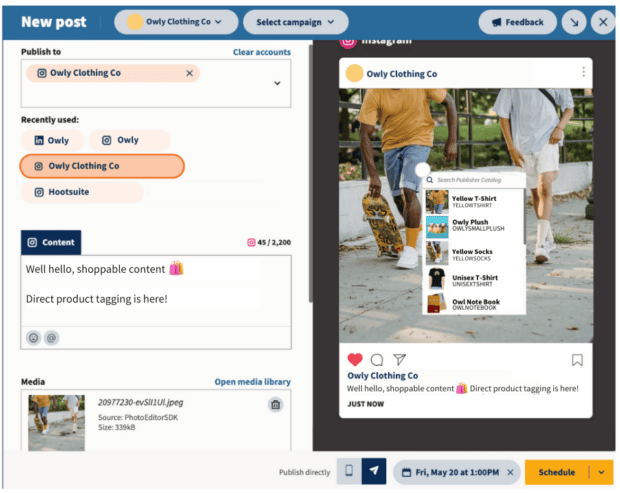
Social media ecommerce statistics
Still not convinced to give social media ecommerce marketing a try? We’ll let hard data do some talking.
In 2022, sales through social media platforms hit an estimated $992 billion. That’s expected to hit $2.9 trillion by 2026. Needless to say, social media is the place to be for ecommerce brands.

What’s driving that growth? A few things.
According to Hootsuite’s Global State of Digital 2022 report:
- There are 4.7 billion social media users worldwide
- 47 million new social users are added each month
- Users spend 2 hour 29 minutes per day, on average, on social media
- And they use an average of 7.4 different social platforms each month
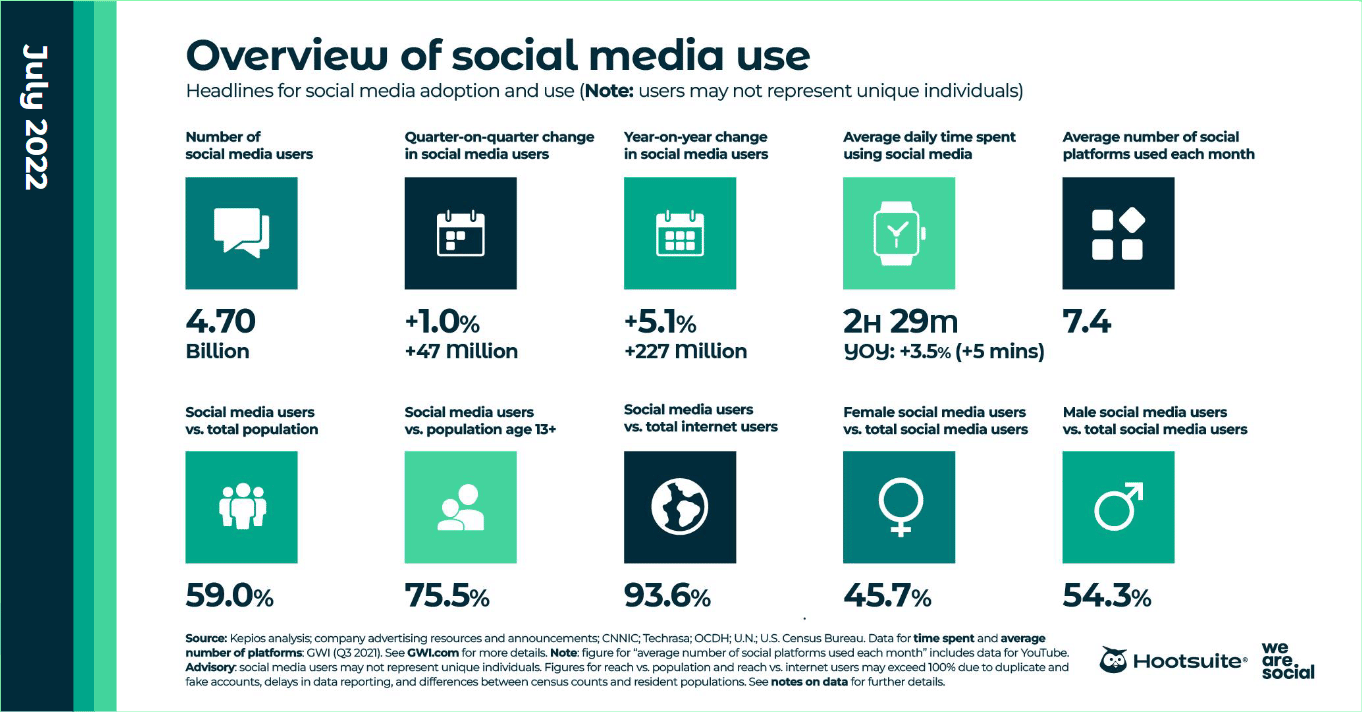
Social media is popular (duh). And it’s getting exponentially more popular globally.
At the same time, social commerce is also exploding. 30% of internet users in the United States make purchases directly on social media. And they’re only in second place. China is the clearcut leader for social commerce. Almost half of Chinese internet users shop through social platforms.
Facebook was the most popular social channel for purchases in 2022 (likely propped up by Marketplace). Hot on its heels are Instagram, Pinterest, and TikTok.
The main growth story in social ecommerce, however, is TikTok. It has seen explosive growth in the last few years, surpassing 1 billion active users in 2021.
This translates into a monster opportunity for ecommerce marketers. According to Hootsuite’s reporting, TikTok ads have a potential reach of 1.02 billion. And, according to TikTok itself, 39% of users have used the platform to discover a product or brand. And 47% say they’ve bought something on TikTok.
Instagram, for its part, is no sleeper either. With a total potential ad reach of 1.44 billion, Instagram is a social commerce channel that can’t be ignored.
Brands have more social commerce tools and larger audiences at their disposal than ever before.
Social media ecommerce FAQ
Which social media is best for ecommerce?
It depends on your marketing and sales goals. TikTok is a game-changer for brand awareness. Instagram and Facebook are the leaders in social commerce and direct sales. Pinterest is perfect for lifestyle marketing. Together, all social platforms create an unbeatable web of opportunities for sales and marketing.
What is the role of social media in ecommerce?
The role of social media in ecommerce is to build brand awareness, advertise to target user segments, sell products, improve and extend customer support, and engage in conversation and community building.
What are the advantages of using social media for ecommerce?
The advantages of using social media for ecommerce include extending your marketing to new channels, growing an engaged audience, distributing valuable content and promotions to your target market, interacting with customers and prospects, and driving new sales.
What is the impact of using social media for ecommerce?
Social media helps develop stronger and more meaningful relationships between brands and customers. Social accounts double as customer support and direct communications channels. This helps grow stronger brand affinity and relationships with customers. Once that’s achieved, social commerce enables direct, frictionless selling to engaged and loyal audiences.
Source: https://blog.hootsuite.com/social-media-ecommerce/


